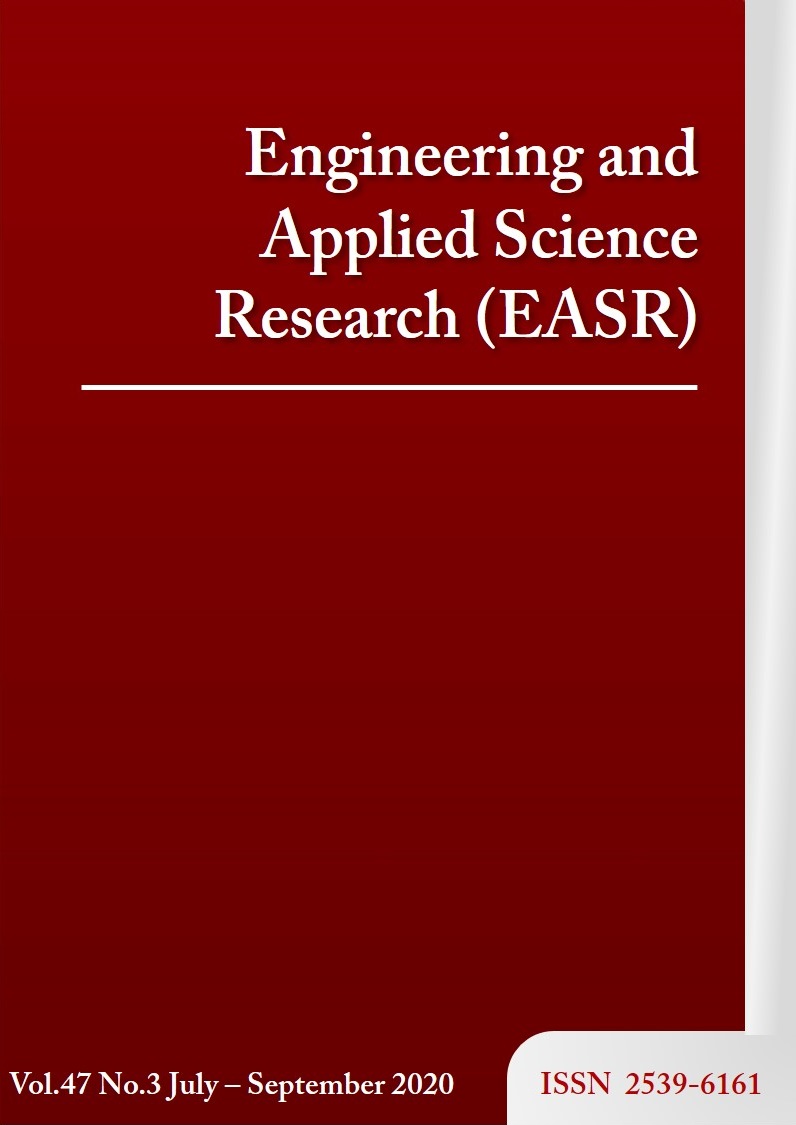Functionalized nonwoven Nylon fabrics for cadmium ion exchange applications
Main Article Content
Abstract
Water pollution is a big issue of our world. This research aims to study the possibility of using carboxylate functionalized synthetic nonwoven fabrics for removing heavy metals from contaminated water. Poly(acrylic acid) (PAA) and poly(itaconic acid) (PIA) were grafted from the surfaces of individual Nylon 6,6 fibers of nonwoven fabrics by radiation induced-polymerization with Gamma-rays under various conditions. FTIR spectra show evidence of the carboxylate groups of PAA and PIA after polymer grafting. A comparison of fiber sizes and surface morphology of nonwoven Nylon fabrics before and after PAA and PIA grafting was examined using optical microscopy (OM) and scanning electron microscopy (SEM). The shrinkage, curl and non-uniformity of fibers observed by OM and SEM after polymer grafting might cause the changes in the water permeabilities of the modified Nylon fabrics. After hydrolyzation of modified Nylon fabrics with sodium hydroxide, static cadmium (Cd2+) ion exchange capacities were measured for all fabric samples. The Langmuir model was used to calculate parameters, including maximum static Cd2+ ion exchange capacities and the association coefficients to explain behaviors of unmodified and modified nonwoven Nylon fabrics. Using unmodified and PAA- and PIA- modified Nylon fabrics as ion-exchange membranes, these membranes provide higher water flowability than conventional membranes. Furthermore, the static Cd2+ ion exchange capacities of these ion-exchange membranes are comparable to commercial ion-exchange materials. It was also found that duration time of radiation inducing and heating steps along with various types of polymer grafting affected the ion exchange capacities and membrane performance.
Article Details
This work is licensed under a Creative Commons Attribution-NonCommercial-NoDerivatives 4.0 International License.
References
Odian G. Principles of polymerization. New Jersey: John Wiley & Sons; 2004.
Chitpong N, Husson SM. High-capacity, nanofiber-based ion-exchange membranes for the selective recovery of heavy metals from impaired waters. Separ Purif Tech. 2017;179:94-103.
Wang J, Sproul RT, Anderson LS, Husson SM. Development of multimodal membrane adsorbers for antibody purification using atom transfer radical polymerization. Polymer. 2014;55(6):1404-11.
Chenette HC, Husson SM. Membrane adsorbers comprising grafted glycopolymers for targeted lectin binding. J Appl Polymer Sci. 2015;132(21):1-7.
Chitpong N, Husson SM. Polyacid functionalized cellulose nanofiber membranes for removal of heavy metals from impaired waters. J Membr Sci. 2017;523:418-29.
Bhattacharya S, Inamdar M. Polyacrylic acid grafting onto isotactic polypropylene fiber: methods, characterization, and properties. J Appl Polymer Sci. 2007;103(2):1152-65.
Zheng Y, Liu H, Gurgel PV, Carbonell RG. Polypropylene nonwoven fabrics with conformal grafting of poly (glycidyl methacrylate) for bioseparations. J Membr Sci. 2010;364(1-2):362-71.
Shim JK, Na HS, Lee YM, Huh H, Nho YC. Surface modification of polypropylene membranes by γ-ray induced graft copolymerization and their solute permeation characteristics. J Membr Sci. 2001;190(2):215-26.
Barsbay M, Güven O. RAFT mediated grafting of poly (acrylic acid)(PAA) from polyethylene/polypropylene (PE/PP) nonwoven fabric via preirradiation. Polymer. 2013;54(18):4838-48.
Kováčik D, Zahoranová A, Černák M, Mazúr M. Surface modification of polypropylene non-woven fabrics by atmospheric-pressure plasma activation followed by acrylic acid grafting. Plasma Chem Plasma Process. 2005;25(4):427-37.
Abdel-Hamid H. Effect of electron beam irradiation on polypropylene films—dielectric and FT-IR studies. Solid State Electron. 2005;49(7):1163-7.
Sankhe AY, Husson SM, Kilbey SM. Effect of catalyst deactivation on polymerization of electrolytes by surface-confined atom transfer radical polymerization in aqueous solutions. Macromolecules. 2006;39(4): 1376-83.
Vural S, Seckin T. Brush‐type surface modification of kapton with a new approach. Adv Polymer Tech. 2018;37(6):1703-11.
World Health Organization. Exposure to cadmium: a major public health concern. Preventing Disease through Healthy Environments. Geneva: WHO; 2010.
Arthur DE, Jonathan A, Ameh PO, Anya C. A review on the assessment of polymeric materials used as corrosion inhibitor of metals and alloys. Int J Ind Chem. 2013;4:1-9.
Ma H, Burger C, Hsiao BS, Chu B. Ultra-fine cellulose nanofibers: new nano-scale materials for water purification. J Mater Chem. 2011;21(21):7507-10.
He J, Chen JP. A comprehensive review on biosorption of heavy metals by algal biomass: materials, performances, chemistry, and modeling simulation tools. Bioresour Technol. 2014;160:67-78.
Okieimen F, Sogbaike C, Ebhoaye J. Removal of cadmium and copper ions from aqueous solution with cellulose graft copolymers. Separ Purif Tech. 2005;44(1):85-9.
Stephen M, Catherine N, Brenda M, Andrew K, Leslie P, Corrine G. Oxolane-2, 5-dione modified electrospun cellulose nanofibers for heavy metals adsorption. J Hazard Mater. 2011;192(2):922-7.
Kyzas GZ, Siafaka PI, Lambropoulou DA, Lazaridis NK, Bikiaris DN. Poly (itaconic acid)-grafted chitosan adsorbents with different cross-linking for Pb (II) and Cd (II) uptake. Langmuir. 2014;30(1):120-31.
Güçlü G, Gürdağ G, Özgümüş S. Competitive removal of heavy metal ions by cellulose graft copolymers. J Appl Polymer Sci. 2003;90(8):2034-9.
Chitpong N, Husson S. Nanofiber ion-exchange membranes for the rapid uptake and recovery of heavy metals from water. Membranes. 2016;6(4):1-16.
Ramakrishna S, Ma Z, Matsuura T. Polymer membranes in biotechnology: preparation, functionalization and application. London: Imperial College Press; 2011.
Du Y, George S. Molecular layer deposition of nylon 66 films examined using in situ FTIR spectroscopy. J Phys Chem C. 2007;111(24):8509-17.
Wang L, Fu Y, Wang Z, Fan Y, Zhang X. Investigation into an alternating multilayer film of poly (4-vinylpyridine) and poly (acrylic acid) based on hydrogen bonding. Langmuir. 1999;15(4):1360-3.
Limousin G, Gaudet JP, Charlet L, Szenknect S, Barthes V, Krimissa M. Sorption isotherms: a review on physical bases, modeling and measurement. Appl Geochem. 2007;22(2):249-75.
Tofighy MA, Mohammadi T. Adsorption of divalent heavy metal ions from water using carbon nanotube sheets. J Hazard Mater. 2011;185(1):140-7.
Kumar U. Agricultural products and by-products as a low cost adsorbent for heavy metal removal from water and wastewater: a review. Sci Res Essays. 2006;1(2):033-7.
Zhang L, Zhou J, Zhou D, Tang Y. Adsorption of cadmium and strontium on cellulose/alginic acid ion-exchange membrane. J Membr Sci. 1999;162(1-2):103-9.
Üçer A, Uyanik A, Aygün Ş. Adsorption of Cu (II), Cd (II), Zn (II), Mn (II) and Fe (III) ions by tannic acid immobilised activated carbon. Separ Purif Tech. 2006;47(3):113-8.



